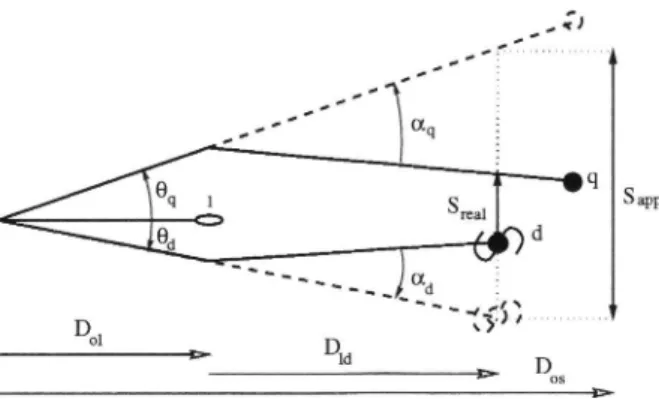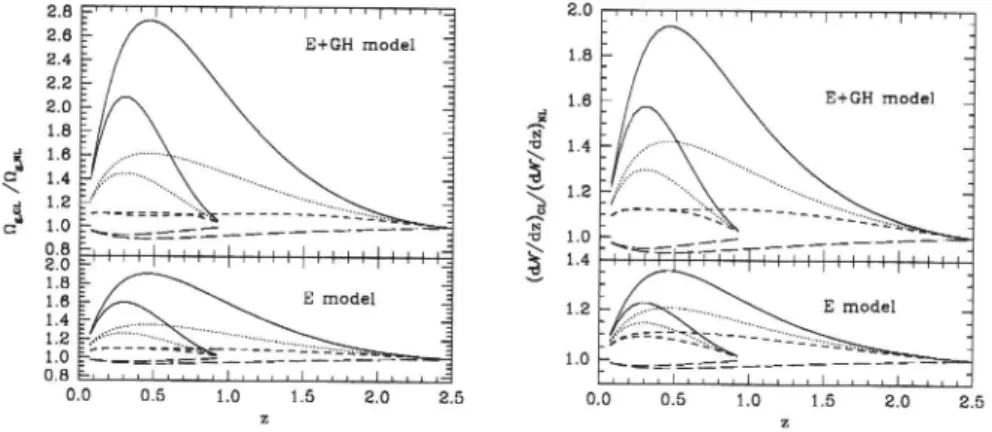Damped
Ly-a
Absorbers and
Gravitational
Lensing
Alain Smettel'2, Jean-Flangis Claesketrs3'4, Jean Surdej3'5
I Kapteyn Astronom'i,cal Institute, P.O. Boa 800, NL-9700 AV Groningen, The
Nether-lanils
2now at NASA-GSFC, Cod,e 681, Greenbelt MD 20771, U.S.A.
s lnstitut d'Astrophysique et de Géophgsique, Auenue ile Cointe 5, 8-1000 Liège,
Bel-gium
4Research Assistont, Belgian Fund for Scientific Reseach (FNRS)
sResearch Director, Belgi,an Fund
lor Scientific Reseach (FNRS)
Abstract.
Gravitational lensing and damped Ly-a (DLA) absorbers may stronglyinterplay: multiple imaging allows
to
estimate the DLA transverse size, but singleimaging gravitational deflection can lead to over-estimate the separation between a DLA optical counterpart and the QSO line-of-sight; as a consequence of the magnifi-cation bias the number density of DLAs and the cosmological density of neutral gas
may be significantly be over-estimated in z
1
L DLA surveys.1-
Introduction
Three different cases
of
interplay between gravitational lensing andDLA
ab-sorption can be considered:
o
a multiply imaged lensed quasar; the DLA absorber is not necessarily re-lated to the lensing agent; two examples are given by the systems HE1104-1805[7, 4] and Q 1429-008[8, 10], which indicate that the column density profile of a DLA absorber àt z
-
1.6 have a typical scale of 20h-1
kpc;o
a lensing foreground galaxy or galaxy cluster locatedin
front of a DLA absorber and a (singly imaged) QSO lead to over-estimate the linear sep-aration between the DLA optical counterpart and the QSO line-of-sight;o
the DLA absorber is the lensing agent;it
does possibly, but not necessarily,lead to the formation of multiple images of the background quasarl because
of lensing effects, especially the magnification bias, the number density of DLAs and the cosmological density of neutral gas can be over-estimated in z
11
DLA surveys.Figure 1: The apparent linear separation ,55o0 between a DLA optical counter-part and a QSO line-of-sight may severely over-estimate the real value S""rr
if
a galaxy or galaxy cluster is located close to the line-of-sight towards theback-ground QSO. co and c6 are the angular deflection angles for the QSO and the
DLA respectively; the D;3 are angular diameter distances.
2
Lensing and
the
impact
parameters
of
DLA
optical
counterparts
The linear separation between a DLA absorber optical counterpart and a QSO
line-of-sight may be significantly over-estimated
if
they are located behind a lens, as a galaxy or a galany cluster, (cf.Fig.
1). Indeed,if Adl
is the observed angular separation between the QSO and the optical counterpart, the real valueof the impact parameter S"ear is related to the apparent one S.oo by:
S,ear
_
,
Dn
ldq- ddl
/1\4; - '- D.d
LÉ,r
'
\r''
For a singular isothermal sphere (SIS),
o
=
220km
s-t
L*
lensat
zr=
0.5 and a zd=
3DLA, the
Einstein radiusfor
a sourceat the DLA
redshift is d$=
0.88". Hence,if
both ld$l and ld$l are largerthan this value, no multiple imaging occurs. The projection of the Einstein radius in the lens plane-
3 kpc.In
the extreme geometry shownin
Fig.
1., one thus overestimates the impact parameter of a z6:
3 absorber by-
6 kpc, which is significant compared to the radius of an HI disk(-
10 kpc).The absorber dynamical mass
M6", is
[5]M6""
:
(o?ot, S.""1)/(Gsin(z)),where o,o1 is the rotational velocity ofthe galaxy
-
evaluated from the differencein velocity between the DLA line and emission lines arising in the optical
coun-terpart
-,
and z is its inclination angle. Assuming a face-on disk and a uniform H I distribution, the H I mass is M111-
10eMo
(N111/1020 cm-2) (^9"""1/20 kpc)2[2].
The confusion between S*oo and Srear may thus leadto
overestimate the dynamical andfI
I absorber masses by upto
an order of magnitude.About
-
3To of the impact parameters of z6=
3 DLAs optical counterparts QSOs are susceptibleto
be over-estimated by more then33%.
This number does not take into account lensing by groups or clusters of galaxies, and should thus be considered as a lowerlimit.
3
Gravitational
lensing
by
DLA
absorbers
Assuming that DLAs arise in present-day like spiral galaxies which are immersed
in
SIS dark matter halos, one can estimate the consequences of gravitational lensing on the measured values of the number density (dN ld,z), distribution of column density(/(N))
and inferred cosmological density ofHl
(Os)
derived fromDLA
surveys[9]. Two lensing effects were considered: the 'by-pass' (or focusing) effect causes the lines-of-sight (LOSs) towards background QSOs toavoid the central parts ofgalaxies: this leads to a reduction ofthe effective cross-section
for DLA
absorption; the 'ampliûcation bias' leads observersto
select QSOs whose LOSs preferentially cross galaxies closeto
their
Einstein radius. Hence, the determination of d,Nld,z,/(N)
andOs
does not only depend onthe redshift z and luminosity Z of the galaxies responsible for the absorbers but
also on the H I column density profile within the galaxies and on the redshift zo and magnitude ôo of the background QSO.
For the existing surveys using b
S
19 QSOs, the amplification bias dominated the combined effect, resultingin
overestimatingdNldz,
f(N)
and Og1. For surveys ideally designed to enhance GL effects, i.e.to
search for z-
0.5 DLAs linesin
the spectraof
ôo-
16, zo)
1 QSOs,dNldz
may be overestimated by 90%,DLA
lines with Ns1>
1021 cm-2 are likelyto
be up yo 4 times more abundant, so that O111 maf be overestimated by a factor of 2.7 (cf.
Fig. 2). Our results are significantly different from a parallel study on the same subject[l].Within the framework of our model, high-z DLA surveys are not signifrcantly affected
by
lensing; however, Os1ma]
be overestimatedby
35%in
thez
< 1 surveys, asthe IUE
survey[3]or
the
DLA
survey basedon
MgII
selected systems[6]. These calculations were done with the explicit assumption of absence of extinction by dust, which needsto
be taken into account consistently with the lensing effects.On the other hand, one can test
if
a DLA survey is affected by gravitationallensing by dividing its redshift path in two parts for which the lensing effects are expected
to
be respectively strong Drt"ors and weak Dweak:if
the estimates of dNlaz
and Os1 appear significantly larger when derived on data belonging onlyto
Ds1"o^, thanto
D"teak, then there is good evidencethat
lensing is actually taking place. Such an exercise based on the surveys published so far indicate that lensing may be indeed important atz
<-1, but unfortunately provided too few2.4 2.6 2.4 2.2 2.0 1.8 1.ô 1.4 t.2 0.8 2.0 1.8 1.6 1.4 1.2 0.8 E*GH model
'::'
\",-"\
-__-==È__èt_ _ _ ______ _l E model:::=Ë:._rÈÈÈ=
1.8 N .! 1.4 Ë<
1.er
,"
:
-:"
1.4 19 c 0.0 0.5 1.0 1.0 1.5 2.OFigure
2:
Effect of gravitational lensing on the estimation of the cosmologicaldensity
of
HI.
Left
(right):
ratio
of
a1q1(dNldz)
when lensing is taken into ?gggylt As,ct" ((dNldz)cr)
to the one derived without any lensing effect Og,wr, ((dNldz)61,), for DLAsin
front ofzr:1.0
andzq:2.5
QSOs. The cuives correspondstoôo:16
(solid),ôq:18
(dot),bo:19
(short-dash) andbq:20
(long-dash). The E+GH and E models corresponds to two different H r column density profiles within galaxies.
T\rrnshek (these Proceedings) can possibly be explained by gravitational lensing.
Acknowledgements.
AS thanks a grant from the Leids Kerkhoven-Bosscha Fonds and the financial support under grant nô. Zgf-Zg-OS8 from the Netherlands Foundation for Research in Astronomy (ASTRON) which receives its funds from the NetherlandsOrganisation for Scientific Research (NWO).
References
[1] Bartelmann, M., Loeb, A. 19g6, ApJ 452,529
[2] Djorgovski, S.G., Pahre, M.A., Bechtold, J., Elston, R., 1996, Nature gg2,2g4 [3] Lanzetta, K. M., Wolfe, A.M., Turnshek, D. A. 1ggb, ApJ 440,485
[4] Lopez, S., Reimers, D., Smette, A. IggT, these Proceedings [5] Lu, L., Sargent, W.L., Barlow, T.A. 1gg7, ApJ, in press
[6] Rao, S. M., T\rrnshek, D. A., Briggs F. H. 199b, ApJ 449, 488 (R'fB)
[7] $-rne!!e,
{.,
Robertson,J.
G, Shaver, P.A.,
Reimers, D., Wisotzki,L.,
andKoehler, T., 1995, A&AS 113, 1gg
[8] Smette, A.,.\Milliger, G.M., Robertson, J.G., Shaver, P.A. 1996, in IAU
Sympo-sium 173: .Astrophusjcali!.nnhlcajio-rys of Grauitational Lensing, Melbournei ,4us-tralia, 9-11 July, 1995, Eds. C.S. Kochanek and J.N. Hewitt,-Kluwer. 103.'19g6. [9] Smette, A., Claeskens, J.-F., Surdej, J.lgg7, New Ast. 2, b3

